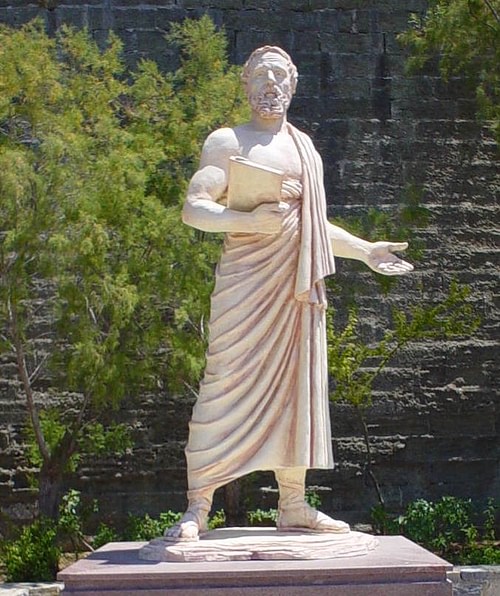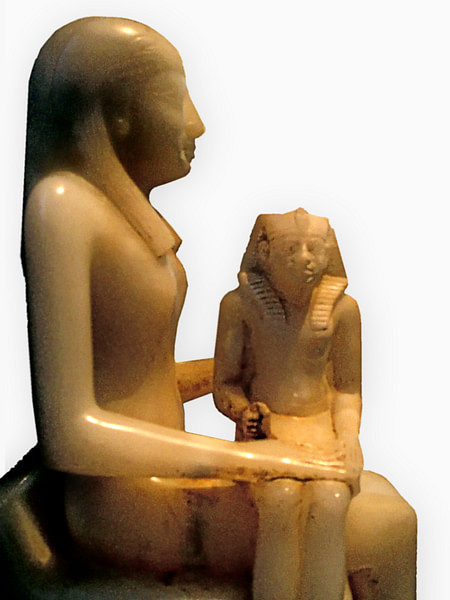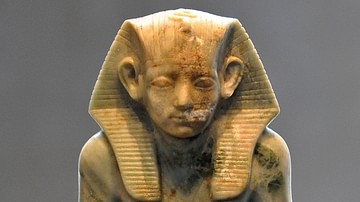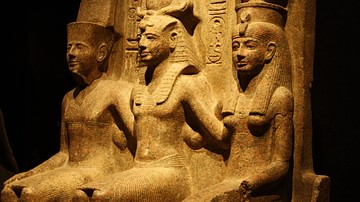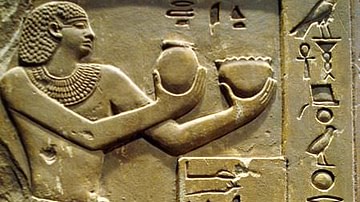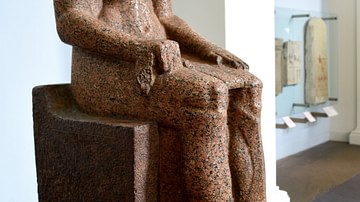
Nitocris (2184-2181 BCE) is the Greek name for Nitiqret, the last monarch of the 6th Dynasty of Egypt which concluded the period of the Old Kingdom (c. 2613-2181 BCE). Nitocris is best known from the story told of her by Herodotus (484-425/413 BCE) in his Histories (Book II.100) in which she murders the assassins of her brother at a banquet.
More than Just a Name?
For the past century the historicity of Nitocris has been questioned by scholars, even though her name appears on the Turin King's List of Egyptian monarchs, is also mentioned by Manetho (3rd century BCE) in his list of 6th century Egyptian monarchs and by Eratosthenes of Cyrene (276-194 BCE) in his Theban List of Egyptian Monarchy. Flavius Josephus (37-100 CE) references Herodotus' story in his Antiquities of the Jews (Book VIII.6.2) calling her Nicaule and does not question the authenticity of the tale. Eratosthenes' mention of Nitocris is known through the work of Apollodorus of Athens (c. 180 BCE) which is cited by Syncellus (c. 810 CE) in his Selection of Chronography. Still, because there is no physical evidence of this queen - no inscriptions, no monuments, no tomb - nor any later reference to her, some scholars have claimed her name is simply a scribal error for that of the last king of the 6th Dynasty, Neitiqerty Siptah.
Recently, however, an increasing number of Egyptologists and scholars have come to accept that Herodotus' account may have some basis in fact and Nitocris is increasingly being recognized as the first Queen Regnant of Egypt and the last monarch of the Old Kingdom. The underlying reason for this new evaluation of Nitocris is unclear but may have to do with the kind of evidence first presented by the Egyptologist Percy E. Newberry (1869-1949 CE) who argued that Nitocris was an actual Egyptian ruler, not just a character in a fable repeated by Herodotus, and that her historicity should be accepted.
Herodotus & Other Accounts
Herodotus' account of Nitocris is often cited as the only evidence of the queen in history. While it is the only source for the story of her revenge, there are, as noted, other sources. Herodotus writes:
After him came three hundred and thirty kings, whose names the priests recited from a papyrus roll. In all these many generations there were eighteen Ethiopian kings, and one queen, native to the country; the rest were all Egyptian men. The name of the queen was the same as that of the Babylonian princess, Nitocris. She, to avenge her brother (he was king of Egypt and was slain by his subjects, who then gave Nitocris the sovereignty) put many of the Egyptians to death by treachery. She built a spacious underground chamber; then, with the pretence of inaugurating it, but with quite another intent in her mind, she gave a great feast, inviting to it those Egyptians whom she knew to have had the most complicity in her brother's murder; and while they feasted, she let the river in upon them by a vast secret channel. This was all that the priests told of her, except that when she had done this she cast herself into a chamber full of hot ashes, to escape vengeance. (Histories, II.100)
Scholars became suspect of this account when no Egyptian sources were found to corroborate it and even more so when it was considered that Herodotus reported a similar event only a few chapters later. In chapter 107 of the same book he relates the story of the Egyptian king Sesostris who returns home from a campaign and stops near Pelusium where he meets his brother, whom he had left in charge of the country while away. A great banquet is held in honor of the king but, while he and his family are inside, his brother orders the building ringed with wood and set on fire. Sesostris escapes only by sacrificing two of his sons to the flames as a human bridge which enables the others to reach safety. The king later deals with his treasonous brother (Histories II.107).
This story also has no known corroboration in Egyptian history and, further, a number of kings have been associated with Sesostris (among them Senusret III, Amenhotep III, and Ramesses II). Sesostris has also been cited by a number of ancient historians as the first to conquer the known world or to have conquered Egypt and so is regarded as a mythical figure, an amalgam of different stories of different Egyptian kings, not historical.
Manetho simply lists Nitocris' name and credits her as "braver than any man of her time" and of exceptional beauty (Waddell, 54). He also, however, credits her with "building the third pyramid" which has been rejected completely by Egyptologists because it is well established that the third pyramid was built by Menkaure (2532-2503 BCE).
Eratosthenes lists her as ruling for six years from Thebes and notes she was the 22nd ruler since Menes, "a queen, not a king, her name means 'Athena the Victorious'" but gives no further details. Josephus mentions her as Nicaule, cites Herodotus, but does not elaborate on the revenge story. Apollodorus of Athens preserved Eratosthenes' table of Egyptian kings and Syncellus later cited it also without any additional information. This lack of any corroboration of Herodotus' account is how Nitocris came to be regarded as mythical. However, Percy E. Newberry, in 1943 CE, argued that these other sources should be taken more seriously in establishing the historicity of Nitocris and, further, that physical evidence in Egypt was available if one knew what one was looking for.
Newberry's Argument
Percy E. Newberry is nowhere near as well known as he should be. It was Newberry who first brought Howard Carter to Egypt in 1891 CE and set Carter on the path toward discovering the tomb of Tutankhamun in 1922 CE. Newberry, in fact, would work with Carter on the excavation and evaluation of the contents, being especially knowledgable in botany and able to identify certain organic elements in the tomb.
In The Journal of Egyptian Archaeology, Volume 29, Newberry presented his case in the article Queen Nitocris of the Sixth Dynasty in which he states how he finds it "remarkable" that his colleagues should consider this woman as either a king or mythical character when a preponderance of evidence exists to establish her authenticity as the first fully attested queen of Egypt (51-52).
Nitocris, according to Newberry, is not only listed on the Turin King's List but the Abydos King's List and, further, her tomb can be identified at Saqqara. He interprets Nitocris' name as "Neith is Excellent" and demonstrates how the name Neith appears on the tomb of one of Pepi II's queens.
He then makes an interesting observation concerning Manetho's repudiated claim that Nitocris built the third pyramid. Newberry points out that the great Egyptologist Flinders Petrie noted some years earlier how Manetho simply says she built the third pyramid and that scholars since have assumed he meant the third at Giza; but this may not be his meaning at all. It is possible, since Manetho gives no location for this "third pyramid", that he was referring to the third at Saqqara, not at Giza. Newberry then points out that the third pyramid at Saqqara is that of Neith (53).
Even if Manetho does mean the third pyramid at Giza, Newberry observes, this still does not mean one should reject his account since the prenomen (given name) of the woman in the tomb of Neith at Saqqara may have been Menkare which could have been easily confused for Menkaure (54). Nitocris, Newberry claims, may have been the wife of Pepi II who lived so long that all his heirs died long before he did. In such a situation, his wife could have stepped in to rule. This interpretation is in keeping with Eratosthenes' report that Nitocris was "a queen, not a king", a line which can also be interpreted as "a wife, in place of her husband".
Support for Herodotus' Account
Newberry's evidence regarding the tomb, and the interpretation of Eratosthenes' line, however, do not support Herodotus' account of a queen avenging herself for her king-brother's murder, however, since Pepi II was not her brother and, besides, lived and reigned upwards of sixty years. Arguments that she was the wife of Merenre I (2287-2278 BCE) also fail in that he was not murdered nor did he die young. Further, Pepi II's wife Neith does not fit the time period for the reign of Nitocris nor is her pyramid tomb at Saqqara the third built; Egyptologists have long held that Neith's tomb was the first constructed and the most elaborate after the king's.
Arguments that she was the sister of Merenre Nemtyemsaf II (2184 BCE), Pepi II's son and successor, have been considered - and are still the most likely - but were rejected when it was thought Nitocris was a fictional character. One could argue that her brother was Neitiqerty Siptah (also given as Netjerkare Siptah), usually listed as the last king of the 6th Dynasty and who did have a short reign. This king's time on the throne, however, corresponds exactly to Nitocris' own; which is why Egyptologists came to believe her name was simply a scribal mistake for his.
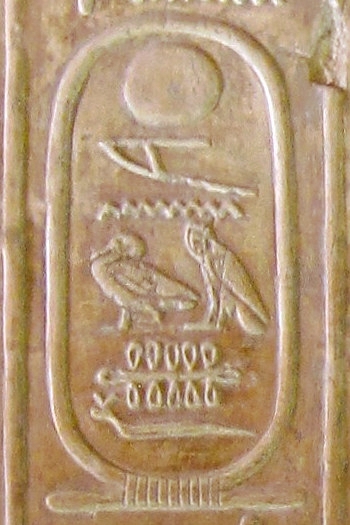
The most probable explanation is that Nitocris was the sister of Merenre Nemtyemsaf II, who reigned for only a year after Pepi II, and would have been the last king before Nitocris. Egyptologist Jaromir Malek, among others, contends that the chaos which ensued after Pepi II's death resulted in confused and missing records and that the queen Nitiqret (Nitocris) was the last monarch of the 6th Dynasty:
Pepy II was succeeded by Merenra II (Nemtyemsaf), Queen Nitiqret (2184-2181 BC), and some seventeen or more ephemeral kings who represent Manetho's 7th and 8th Dynasties...Most of these rulers are little more than names for us but several of them are known from the protective decrees issued for the temple of Min at Koptos. (Shaw, 107)
The 6th Dynasty had been disintegrating for some time during the reign of Pepi II and his death "provoked a dynastic crisis more serious than anything Egypt had faced since the foundation of the state" (Wilkinson, 103). The Egyptians kept very careful records of everything they did but those from the end of the 6th Dynasty are confused or non-existent. Egyptologists routinely describe the collapse of the Old Kingdom as a time of great social upheaval and political confusion. Wilkinson, writing on Nitocris and the collapse, notes that, "Neitiqerty Siptah was of uncertain descent and we cannot even be certain about gender: the name suggests a man but later tradition identified Neitiquerty as a reigning queen" and that "after Neitiquerty (who left no monuments or even inscriptions), the throne passed from one weak ruler to another" (103).
In the midst of this crisis following Pepi II's death, Merenre II seems to have lacked the skills to maintain order. It is possible that Nitocris was seen as a stronger ruler than her brother - whomever he may have been - and so was elevated to the throne after a coup. This is pure speculation, however, since no evidence - other than Herodotus' report - exists. Still, more scholars now accept the account as valid than probably at any other time in the past. Egyptologist Barbara Watterson writes:
The first Queen Regnant of Egypt was Nitocris (c. 2180 BC), of whom nothing much is known except that she came to the throne at a time of political instability on the death of an aged king, Pepi II, who had reigned for over ninety years. Manetho asserted that she was the 'noblest and loveliest of the women of her time, of fair complexion' and, according to Herodotus, she committed suicide after taking vengeance on the men who had murdered her brother in order to put her on the throne. With the death of Nitocris, the Old Kingdom came to an end. (110)
Malek, Watterson, and Wilkinson, all Egyptologists of high standing, make no concession to the old understanding of Nitocris as a mythical figure or the result of an ancient spelling error. Although Newberry's claims regarding the pyramid tomb at Saqqara are questionable, his argument that Nitocris should be accepted because she is included on two king's lists, as well as accepted without question by the scholar Eratosthenes, holds more weight. There are many rulers, as Malek notes, who are "little more than names" from around the same period and whose historicity goes unquestioned. The queen from Herodotus' account is now recognized as an actual historical figure even though scholars are still working with the same information they had 100 years ago.
Conclusion
An interesting detail from the ancient sources is how Manetho lists Nitocris' reign as twelve years total while Eratosthenes gives her reign as six from Thebes (Pritchard, 103). It is possible, following Herodotus' account, that the sister of the king was placed on the throne following a coup at Memphis. She then reigned from the traditional capital while constructing her underground banquet hall at Thebes where she would eventually punish the assassins who had been her supporters. The latter part of her reign, then, would have been from Thebes where she exacted her vengeance and then killed herself.
Herodotus claims she committed suicide to escape retribution but, as an Egyptian queen, could have also done so to atone for the sin of murder. An Egyptian monarch was expected to maintain the value of ma'at (balance and harmony) and the killing of a number of nobles at a party one was hosting would have been considered an offense against ma'at and a serious sin. This, of course, is speculative but probable in such a scenario. Although the 7th and 8th Dynasties continued to rule from Memphis, it would be Herakleopolis and Thebes which would emerge as the the two seats of power in the next era and Thebes was already well established and prosperous when Nitocris would have moved there.
It would also not have been surprising for a woman to take the throne. Female rulers in Egypt were rare but there certainly is precedent from the Early Dynastic Period (c. 3150-c.2613 BCE). The wife of the first king, Narmer (c. 3150 BCE), Neithhotep is thought to have ruled following his death and it is certain that Queen Merneith (c. 2990 BCE) acted as regent for her son Den (c. 2990-2940 BCE), the fifth king of the First Dynasty and may have ruled on her own. According to scholar Francesco Raffaele, "In the reign of the third king of Manetho's 2nd Dynasty, Binothris (Njnetjet), the priest of Sebennytos reports it was decided that the women could eventually reign" (2). Following the time of Nitocris there would be other powerful women such as Sobekneferu (c.1807-1802 BCE) who reigned under her own authority and Queen Ahotep I (c. 1570-1530 BCE) who mobilized the military to put down a rebellion while her son Ahmose I was away on campaign.
Throughout the New Kingdom (c. 1570-1069 BCE) there were many strong women who exerted a powerful influence over Egypt whose names are well known: Hatshepsut, who reigned as pharaoh; Tiye, wife of Amunhotep III; Nefertiti, wife of Akhenaten; and Nefertari, wife of Ramesses II not to mention those who exercised power through the position of God's Wife of Amun into the Third Intermediate and Late periods of the culture and others who did the same as King's Mother. Considering all the evidence at one's disposal, it is probable that there did exist a queen known to the Greeks as Nitocris who tried to maintain order in the chaos of the Old Kingdom collapse and died in that attempt.
